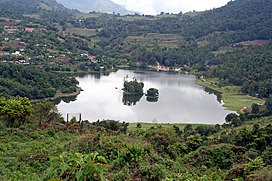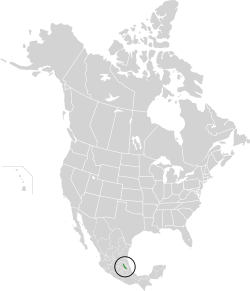Veracruz montane forests
| Veracruz montane forests | |
|---|---|
 | |
 Location of the Veracruz montane forests ecoregion | |
| Ecology | |
| Realm | Neotropical |
| Biome | tropical and subtropical moist broadleaf forests |
| Borders | Sierra Madre Oriental pine-oak forests, Trans-Mexican Volcanic Belt pine-oak forests and Veracruz moist forests |
| Geography | |
| Area | 4,942 km2 (1,908 sq mi) |
| Country | Mexico |
| States | Hidalgo, Puebla, and Veracruz |
| Conservation | |
| Conservation status | Critical/endangered |
| Protected | 303 km² (6%)[1] |
The Veracruz montane forests (Spanish: Bosques montanos de Veracruz) is a tropical moist broadleaf forest ecoregion in eastern Mexico. It includes a belt of montane tropical forest on the eastern slope of the southern Sierra Madre Oriental and eastern Trans-Mexican Volcanic Belt ranges. These forests lie between the lowland Veracruz moist forests and the pine-oak forests of the higher mountains.
The Veracruz montane forests are the northernmost tropical montane moist forests in North America.[2]
Flora[]
The forests are composed of evergreen broadleaf trees, which form a closed canopy. Epiphytes, including orchids, bromeliads, mosses, and lichens, are abundant.[3]
The upper and lower montane forests vary somewhat in species composition. Lower montane forests predominate between 1,250 and 1,630 meters elevation. Characteristic trees are , Liquidambar styraciflua, and , with Quercus sartorii, Quercus xalapensis, , and others.[3]
In the upper montane forests Prunus rhamnoides and Quercus corrugata are the predominant species from 1800 to 2250 meters elevation, together with , , , , and others. Forests dominated by Fagus grandifolia also grow in the upper montane zone, mostly between 1800 and 1900 meters elevation, with , , Persea americana, and .[3]
Fauna[]
Mammals native to the ecoregion include the six species of large cats – jaguar (Panthera onca), ocelot (Leopardus pardalus), margay (Leopardus weidii), puma (Puma concolor), jaguarundi (Herpailurus yagouaroundi), and bobcat (Lynx rufus). Hoofed mammals include the white-tailed deer (Odocoileus virginianus), red brocket (Mazama americana), and collared peccary (Tayassu tajacu). other mammals include the ringtail (Bassariscus astutus), long-tailed weasel (Neogale frenata), kinkajou (Potos flavus), tayra (Eira barbara), Mexican tree porcupine (Coendou mexicanus), nine-banded armadillo (Dasypus novemcinctus), and northern tamandua (Tamandua mexicana).[4]
Native birds include the military macaw (Ara militaris), great curassow (Crax rubra), crested guan (Penelope purpurascens), white-crowned parrot (Pionus senilis), red-tailed hawk (Buteo jamaicensis), and many neotropical migratory birds.[4]
Protected areas[]
A 2017 assessment found that about 40% of the ecoregion is still forested. 303 km², or 6%, of the ecoregion is in protected areas.[1] Protected areas include the Sierra Gorda Biosphere Reserve, , , , Zona Protectora Forestal Vedada Cuenca Hidrográfica del Río Necaxa Natural Resources Protection Area (which is also a Ramsar Site), and the Cacalotepec fracción primera y fracción segunda and Área de Preservación de la Naturaleza y Zona de Usos Múltiples para el Ecoturismo Kolijke voluntary conservation areas.[5]
See also[]
External links[]
- "Veracruz montane forests". Terrestrial Ecoregions. World Wildlife Fund.
References[]
- ^ a b Eric Dinerstein, David Olson, et al. (2017). An Ecoregion-Based Approach to Protecting Half the Terrestrial Realm, BioScience, Volume 67, Issue 6, June 2017, Pages 534–545; Supplemental material 2 table S1b. [1]
- ^ "Veracruz montane forests". Terrestrial Ecoregions. World Wildlife Fund.
- ^ a b c Williams-Linera, G., Toledo-Garibaldi, M. & Hernández, C.G. How heterogeneous are the cloud forest communities in the mountains of central Veracruz, Mexico?. Plant Ecology 214, 685–701 (2013). https://doi.org/10.1007/s11258-013-0199-5
- ^ a b Wiken, Ed, Francisco Jiménez Nava, and Glenn Griffith. 2011. North American Terrestrial Ecoregions—Level III. Commission for Environmental Cooperation, Montreal, Canada.
- ^ "Veracruz montane forests". DOPA Explorer 4.0. Accessed 23 November 2021. [2]
- Ecoregions of Mexico
- Montane forests
- Natural history of Hidalgo (state)
- Natural history of Puebla
- Natural history of Veracruz
- Neotropical tropical and subtropical moist broadleaf forests